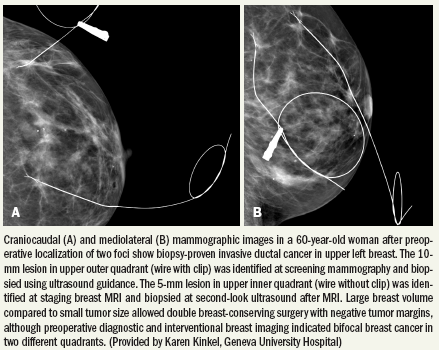Percutaneous needle biopsies require specific skills, good QA
The organizers of the national breast screening program in Croatia have encountered some significant initial difficulties, but they have taken decisive action to solve them, ECR attendees were told at the ESR meets Croatia session.
The organizers of the national breast screening program in Croatia have encountered some significant initial difficulties, but they have taken decisive action to solve them, ECR attendees were told at the ESR meets Croatia session.
“We met some problems because some regions of the country are underequipped and understaffed,” said Prof. Miljenko Marotti, from the department of radiology, University Hospital “Sisters of Mercy” Medical Faculty, University of Zagreb. “At the beginning, we had higher than acceptable recall rates in some areas and from some mammography teams. We have tried to solve the problem with additional educational workshops.”

Insufficient numbers of secondary centers with image-guided biopsy and ultrasound capabilities led to scheduling problems in tertiary centers, he said.
The program was adopted by the government in June 2006 and started in practice in October 2006. Two local screening schemes were organized before the national program was introduced.
The organizers’ goals are to reduce breast cancer mortality by 25% within 10 years of the beginning of the program, to improve patients’ quality of life, and to reduce high costs from treating women in advanced stages of the disease. The target population is women aged between 50 and 69, of which there are nearly 614,000 in Croatia. Women were invited for mammography by mail, sent by the local Department of Public Health. The number of women invited was around 607,000.
Mammography will be performed every two years. The screening equipment includes 80 mammography units and two mobile units. All the equipment was less than 10 years old. Some new mammography units were installed in underequipped areas. The American College of Radiology’s BI-RADS (Breast Imaging Reporting and Data System) Lexicon was translated into Croatian.
A report of the Public Health Institute about the screening program shows that up to February 2009, the overall participation rate had reached 56%, but that there were wide regional variations.
“The differences between the counties cannot be explained by geographical position only because the difference is evident between the Dalmatian counties, as well counties in the northern part of the country,” Marotti said.
Up to January 2009, there were 1217 confirmed cases of breast cancer. There is a three or four months delay in breast cancer confirmation. The figures are 9.2% for BI-RADS 0, 81.8% for BI-RADS 1 and 2, 7.9% for BI-RADS 3, 0.9% for BI-RADS 4, and 0.16% for BI-RADS 5, which is comparable to other studies.
“Unfortunately, we are missing some data because of inappropriate software for collecting data such as lymph node status,” he said. “The software will be replaced, we hope. In the years to come, we have to improve the organization to yield a better participation rate, which
is crucial for reduction of the mortality rate.”
Prof. Damir Miletic, from the department of radiology at Rijeka University Hospital, discussed the incorporation of percutaneous needle biopsy procedures into practice. This requires specific skills and implementation of a quality assurance program to monitor the success of procedures, he said. QA should include the positive predictive value, missed cancer rate, histopathologic underestimation of the lesion, rate of complications, and the need for a second biopsy, both immediate and delayed.
“It is generally accepted that auditing is a useful QA procedure that provides feedback, both to mammography facilities and to individual interpreting radiologists,” he said. “It is particularly important for BI-RADS 3 and 4 lesions. Negative findings of breast biopsies require comparison of imaging findings, physical examination, and histology to decide whether rebiopsy or follow-up of the suspicious breast lesion yields satisfactory results.”
Lack of follow-up data makes it difficult to assess the accuracy of a stereotactic core needle biopsy, he said.
Emerging AI Algorithm Shows Promise for Abbreviated Breast MRI in Multicenter Study
April 25th 2025An artificial intelligence algorithm for dynamic contrast-enhanced breast MRI offered a 93.9 percent AUC for breast cancer detection, and a 92.3 percent sensitivity in BI-RADS 3 cases, according to new research presented at the Society for Breast Imaging (SBI) conference.
The Reading Room Podcast: Current Perspectives on the Updated Appropriate Use Criteria for Brain PET
March 18th 2025In a new podcast, Satoshi Minoshima, M.D., Ph.D., and James Williams, Ph.D., share their insights on the recently updated appropriate use criteria for amyloid PET and tau PET in patients with mild cognitive impairment.
Can Abbreviated Breast MRI Have an Impact in Assessing Post-Neoadjuvant Chemotherapy Response?
April 24th 2025New research presented at the Society for Breast Imaging (SBI) conference suggests that abbreviated MRI is comparable to full MRI in assessing pathologic complete response to neoadjuvant chemotherapy for breast cancer.
Clarius Mobile Health Unveils Anterior Knee Feature for Handheld Ultrasound
April 23rd 2025The T-Mode Anterior Knee feature reportedly offers a combination of automated segmentation and real-time conversion of grayscale ultrasound images into color-coded visuals that bolster understanding for novice ultrasound users.